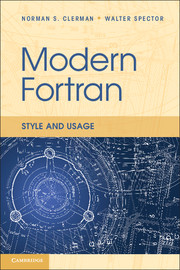Book contents
- Frontmatter
- Contents
- Source Code Listings
- Preface
- 1 Introduction
- 2 General Principles
- 3 Formatting Conventions
- 4 Naming Conventions
- 5 Documentation Conventions
- 6 Programming Principles
- 7 Programming Conventions
- 8 Input and Output
- 9 Packaging Conventions
- 10 Generic Programming
- 11 Object Orientation
- 12 Parallel Processing
- 13 Numerical Types, Kinds, and Operations
- 14 C Interoperability
- 15 Updating Old Programs
- A Source Code
- B Rule List
- Bibliography
- Index
3 - Formatting Conventions
Published online by Cambridge University Press: 05 December 2011
- Frontmatter
- Contents
- Source Code Listings
- Preface
- 1 Introduction
- 2 General Principles
- 3 Formatting Conventions
- 4 Naming Conventions
- 5 Documentation Conventions
- 6 Programming Principles
- 7 Programming Conventions
- 8 Input and Output
- 9 Packaging Conventions
- 10 Generic Programming
- 11 Object Orientation
- 12 Parallel Processing
- 13 Numerical Types, Kinds, and Operations
- 14 C Interoperability
- 15 Updating Old Programs
- A Source Code
- B Rule List
- Bibliography
- Index
Summary
Source Form
Always use free source form.
Fortran 90 introduced free source form. We recommend that it always be used in new code. Free source form offers a number of advantages over the older fixed source form code:
Free source form is more compatible with modern interactive input devices than fixed form. The maximum line length is 132 characters, compared to the older limit of 72 characters. This reduces the possibility of text exceeding the limit, which could lead the compiler to misinterpret names.
Line continuations in free form are performed by using a trailing ampersand character, &, rather than entering a character in column 6 of the following line. As an additional visual reminder and safeguard, a leading ampersand, placed in any column, is also allowed to precede the remaining source code.
In fixed source form, the first six columns are reserved for statement labels, with column 1 also used to indicate comment lines. In modern code, using structured control statements, statement labels are rare. The first five columns are therefore wasted because they are rarely used. These last two features, combined with the next, provide much greater flexibility laying out the code.
[…]
- Type
- Chapter
- Information
- Modern FortranStyle and Usage, pp. 9 - 23Publisher: Cambridge University PressPrint publication year: 2011

